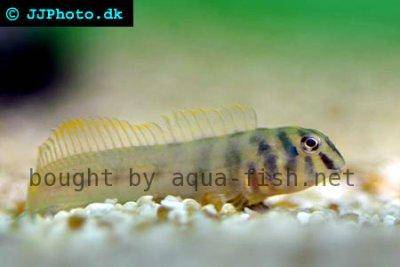Zebra blenny - Omobranchus zebra
Scientific name: Omobranchus zebra
Common name: Zebra blenny
Family: Blenniidae
Usual size in fish tanks: 5 - 6 cm (1.97 - 2.36 inch)
014
Recommended pH range: 7.5 - 8.7
Recommended water hardness: 17 - 30°N (303.57 - 535.71ppm)
0°C 32°F30°C 86°F
Recommended temperature range: 20 - 28 °C (68 - 82.4°F)
The way how these fish reproduce: Spawning
Where the species comes from: South Asia
Temperament to its own species: aggressive/territorial
Temperament toward other fish species: aggressive/territorial
Usual place in the tank: Bottom levels
Food and Feeding
The Zebra Blenny (Omobranchus zebra) is an opportunistic feeder that thrives on a varied diet of live or frozen foods. They readily accept bloodworms, microworms, and brine shrimp. These fish are natural substrate sifters, searching for small organisms, so adding copepods and rotifers to the tank benefits their diet. High-quality sinking pellets or algae wafers can also be offered to supplement their nutrition. Feed them small portions 2-3 times daily to mimic their natural foraging behavior and prevent waste buildup.
Origin
The Zebra Blenny is native to the Indo-Pacific region, with populations found in India, Malaysia, Indonesia, Singapore, and the Philippines. They inhabit coastal waters, estuaries, and mangrove areas, where they adapt to fluctuating salinity levels. These environments are characterized by rocky or sandy substrates, brackish water, and dense vegetation, offering plenty of shelter and feeding opportunities.
Sexing
Sexing Zebra Blennies is challenging, as there are no easily visible differences between males and females. Behavioral observation during the breeding season may help identify males, as they tend to become more territorial and protective of spawning sites.
Breeding
Breeding Omobranchus zebra in captivity is rare but possible under the right conditions. Set up a dedicated breeding tank with brackish water (specific gravity of 1.005-1.015) and provide plenty of hiding spots such as caves, PVC pipes, or rock formations for spawning sites. The male guards the eggs, fanning them to ensure oxygenation and protecting them from predators. The eggs typically hatch within 5-7 days, depending on water temperature. Once hatched, the fry are planktonic and require fine live foods like rotifers or infusoria for initial growth. Maintaining stable water parameters and reducing stress are essential for successful breeding.
Lifespan
With proper care, Zebra Blennies can live 3-5 years in captivity. Stable water conditions, a nutritious diet, and a stress-free environment are crucial for maximizing their lifespan.
Tank Setup
The Zebra Blenny thrives in a brackish tank environment. Use a sandy substrate to accommodate their substrate-sifting behavior, and include rock formations, bogwood, and other decorations to create caves and hiding spots. Floating plants or mangrove roots can help mimic their natural habitat while providing shaded areas. Maintain water salinity at a specific gravity of 1.005-1.015, with ideal water parameters: pH 7.5-8.7, hardness 17-30°N (303.57-535.71 ppm), and temperature 20-28°C (68-82.4°F). Gentle filtration is recommended to ensure clean water without creating strong currents. Regular water changes are essential to maintain optimal water quality.
Compatible Tankmates
Zebra Blennies are territorial and aggressive toward smaller or similarly sized fish, making careful selection of tankmates essential. Ideal companions include larger, peaceful brackish species such as Mono Sebae, or Figure-Eight Puffers. Avoid keeping them with small or slow-moving species that may become targets of aggression. Providing ample hiding spots and visual barriers can help reduce territorial disputes.
Short Description
The Zebra Blenny (Omobranchus zebra) is a unique and active addition to brackish aquariums. This Indo-Pacific species is known for its substrate-sifting behavior and territorial nature. They thrive in tanks with sandy substrates, rock formations, and plenty of hiding spots. While their care requires attention to salinity and water quality, their fascinating behavior and adaptability make them a rewarding choice for experienced aquarists.
Pictures
Bought by aqua-fish.net from jjphoto.dk.



